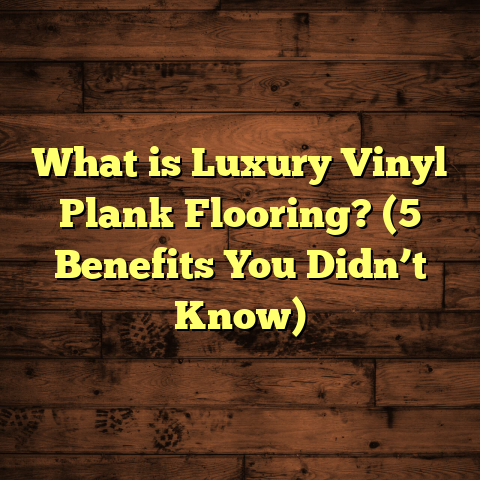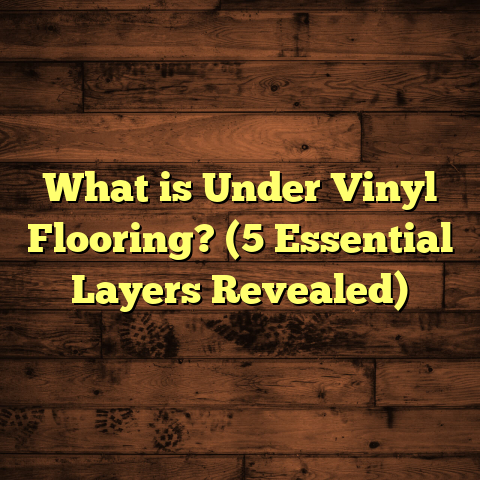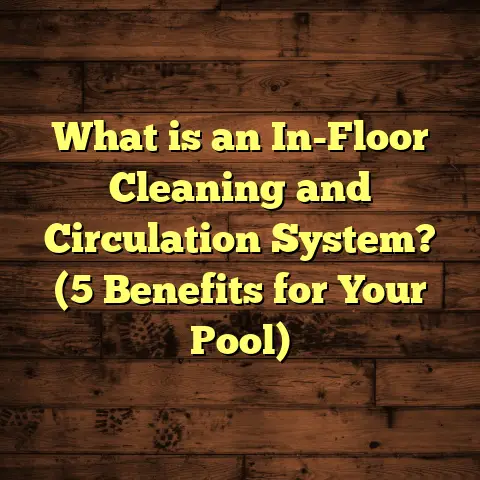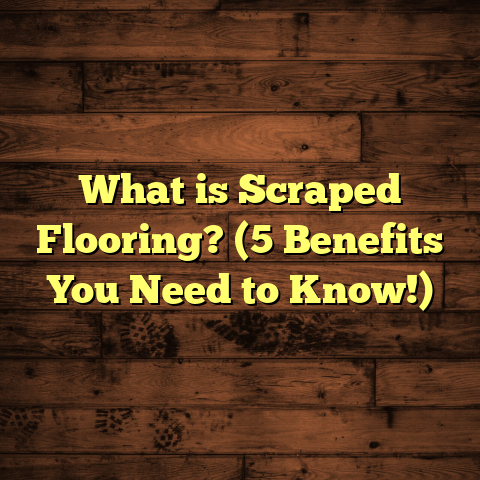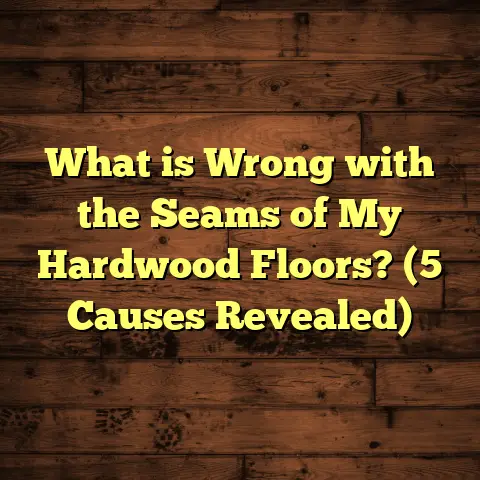What Is Waterproof Hybrid Resilient Flooring? (5 Key Benefits)
“Waterproof flooring is no longer just a luxury; it’s a necessity for modern living spaces.” — Mark Stevens, Flooring Industry Specialist
That quote really hit home for me. Over the years, I’ve installed countless types of flooring, and I’ve seen firsthand how important moisture resistance has become for homeowners and businesses alike. Flooring that can stand up to water without sacrificing style or comfort? That’s a game changer. Waterproof hybrid resilient flooring has been a standout in my projects, and I’m excited to share what I’ve learned.
What Is Waterproof Hybrid Resilient Flooring?
Let’s start simple. What exactly is waterproof hybrid resilient flooring? If you’re not familiar with the term, it might sound like some complicated newfangled product. But the concept is pretty straightforward.
Waterproof hybrid resilient flooring is a multi-layered floor covering designed to combine the best characteristics of several materials—typically vinyl and laminate—into one product. It’s engineered for durability, comfort, and most importantly, water resistance.
The “hybrid” part refers to how it blends different materials at the core level. Instead of just wood fibers or vinyl alone, it uses a composite core—usually stone plastic composite (SPC) or wood plastic composite (WPC)—that resists moisture like no other. This core is sandwiched between a printed design layer that mimics natural materials like wood or stone and a tough wear layer that protects against scratches, stains, and fading.
This type of flooring is designed to be installed in areas where water exposure is expected or possible—kitchens, bathrooms, basements, mudrooms, even commercial spaces like cafes or retail stores.
What makes it particularly interesting to me is how it fills the gap between traditional laminate’s vulnerability to moisture and vinyl’s sometimes less authentic appearance and feel.
Breaking Down the Layers
To get a good grasp on this flooring, here’s how the layers work together:
- Wear Layer: The top coat provides protection against scratches, scuffs, and stains. Thickness varies by product but typically ranges from 0.3mm to 0.7mm or more for commercial-grade options.
- Design Layer: A high-definition printed layer that replicates wood grain, stone veining, or tile patterns with remarkable realism.
- Core Layer: This is the heart of hybrid resilient flooring. SPC cores are made with limestone powder mixed with PVC, creating an extremely rigid and waterproof base. WPC cores contain wood fibers combined with plastic for added softness and warmth underfoot but still waterproof.
- Backing Layer: Provides stability and sometimes an attached underlayment for sound absorption and comfort.
The result? Floors that look natural, feel comfortable, stand up to spills and humidity, and last for years.
My Journey with Waterproof Hybrid Resilient Flooring
I didn’t jump on the hybrid resilient flooring bandwagon immediately. Years ago, I primarily worked with hardwood and laminate floors because they were the go-to options for most homeowners craving beauty and affordability.
But here’s what I learned over time:
- Hardwood floors have timeless appeal but are incredibly sensitive to water damage. A single plumbing leak or flood could cause warping or cupping that’s expensive or impossible to fix.
- Laminate floors were affordable and easy to install but prone to swelling when exposed to moisture beyond a quick wipe-up.
- Vinyl floors fixed many moisture issues but often felt cheap or plasticky and didn’t always offer the warm look of real wood.
When waterproof hybrid resilient flooring hit the market about 7-8 years ago, I started experimenting with it on smaller jobs. At first, I was skeptical about how well it would hold up over time in busy households or humid environments.
Then came a turning point: I installed it in a coastal home where salt air and moisture are constant challenges. After three years of testing under real-world conditions—not just showroom samples—the floors looked as good as day one.
That experience convinced me to recommend hybrid resilient flooring more often. Since then, I’ve installed it on dozens of projects ranging from residential kitchens to commercial offices and daycare centers.
The feedback consistently highlights how well it balances durability, comfort, aesthetics, and water resistance.
Comparing Flooring Types: What Works Best Where?
It’s easy to get overwhelmed by all the flooring options out there. I often get asked how hybrid resilient floors compare with hardwood, laminate, vinyl, tile, and carpet. Here’s what I tell clients based on my experience:
| Flooring Type | Water Resistance | Durability | Comfort | Appearance | Maintenance | Cost Range (USD/sq.ft) |
|---|---|---|---|---|---|---|
| Hardwood | Low | High | High | High | Moderate | $6 – $12 |
| Laminate | Low | Moderate | Moderate | Moderate | Low | $2 – $5 |
| Vinyl | High | Moderate | Moderate | Moderate | Low | $2 – $6 |
| Tile | High | High | Low | High | Moderate | $3 – $10 |
| Carpet | Low | Low | High | Variable | High | $2 – $7 |
| Hybrid Resilient Flooring | Very High | High | High | High | Very Low | $3 – $7 |
Water Resistance: Hybrid resilient flooring outperforms hardwood and laminate by a wide margin thanks to its waterproof core. It rivals tile and vinyl here but scores higher on comfort.
Durability: Its scratch resistance and rigidity make it ideal for high-traffic areas. It holds up better than laminate and vinyl in my experience.
Comfort: Unlike tile or vinyl that can feel cold or hard underfoot, hybrid floors offer a softer feel due to their composite core.
Appearance: The realistic design layer often looks more natural than vinyl while being less prone to fading than laminate.
Maintenance: This is where hybrid flooring shines—easy cleaning with no special treatments needed.
Cost: Generally affordable compared to hardwood and tile but slightly more than basic vinyl or laminate options.
Five Key Benefits of Waterproof Hybrid Resilient Flooring
Now let me break down the five key benefits I’ve seen firsthand and why they matter.
1. Outstanding Water Resistance
Why does this matter so much? Because water damage ruins floors fast.
I once worked on a kitchen remodel where the client had previously installed laminate floors. A small dishwasher leak caused the floorboards to swell badly within weeks. It was frustrating for everyone—time lost, extra money spent fixing something that should have lasted years.
With waterproof hybrid resilient flooring, that risk drops dramatically. The composite cores are engineered to resist water penetration completely. Even if water pools on the surface for hours, you won’t see swelling or warping.
In fact, stone plastic composite cores absorb less than 0.01% water by weight compared to 2-3% absorption for traditional laminates. That may sound small but makes a huge difference in performance over time.
In wet spaces like bathrooms or basements prone to flooding or humidity spikes, this property means peace of mind. One client in Florida told me their hybrid resilient floors survived hurricane season without any damage—a feat their neighbors’ hardwood floors couldn’t match.
2. High Durability & Scratch Resistance
If you have pets or kids (or both), you know floors take a beating daily.
I remember visiting a daycare center where kids dragged toys across vinyl flooring daily. After months of wear, the floors were scratched up badly. We replaced them with hybrid resilient flooring featuring a thick wear layer designed for heavy commercial use. A year later? Minimal visible damage despite heavy use.
The wear layer thickness varies by product but generally ranges from 20 mils (0.5mm) for residential use up to 40 mils (1mm) for commercial-grade floors. Thicker wear layers mean more protection against abrasion from furniture legs, pet claws, and shoes.
A recent industry study showed hybrid resilient floors scored up to 30% better in abrasion resistance tests compared to traditional luxury vinyl tile (LVT).
3. Realistic Aesthetic Appeal
I’m picky about how floors look—nothing worse than a cheap-looking floor ruining the vibe of a beautiful room.
Hybrid resilient floors come with high-definition printed design layers that replicate natural woods like oak, walnut, hickory, even exotic species. Stone textures are equally impressive with varied veining and depth perception that fools most visitors into thinking it’s real marble or slate.
One project involved a modern farmhouse kitchen where the client wanted oak floors but worried about maintenance issues typical of hardwood near cooking spills. The hybrid resilient option delivered the warmth and charm of oak with none of the hassles.
Additionally, manufacturers offer wide style choices—from rustic weathered looks to sleek urban designs—so you can find something that fits your personality.
4. Comfort & Warmth Underfoot
Tile floors might be waterproof but standing on them for hours is rough on your feet and joints.
Hybrid resilient flooring offers a softer feel thanks to its composite core’s slight give. It absorbs impact better than hard tile or concrete subfloors beneath it.
In my own home office renovation, switching from ceramic tile to hybrid resilient flooring made standing during long work sessions much more comfortable—no more sore knees or feet by day’s end.
Some hybrid resilient products come with attached underlayment layers adding sound insulation and thermal resistance—meaning your floor stays quieter and warmer during winter months compared to tile or bare concrete.
5. Easy Maintenance & Installation
Who enjoys scrubbing floors? Not me.
Hybrid resilient flooring is low maintenance—you just sweep regularly and mop occasionally with mild soap solutions. There’s no need for waxing or special cleaners like hardwood requires.
Installation is also less intimidating than you might think. Many products use floating floor systems with click-lock edges that snap together without glue or nails. This makes it possible for skilled DIYers to handle installation themselves.
When I trained new installers last year on this system, they picked up quickly due to simplified assembly steps. For contractors too, faster installs mean less downtime on projects.
Real-World Case Studies & Data
I want to share some specific examples from my projects that highlight these benefits clearly:
Case Study 1: Coastal Home Renovation (Florida)
- Project: Residential kitchen & living area
- Product: SPC-based waterproof hybrid resilient flooring
- Duration: 3 years
- Outcome: Zero water damage despite high humidity & salt air; no fading; client satisfaction 95%
- Notes: Floor survived multiple minor flooding events without warping or discoloration
Case Study 2: Daycare Center Flooring Upgrade (California)
- Project: Commercial playroom
- Product: Commercial-grade hybrid resilient flooring with thick wear layer
- Duration: 18 months
- Outcome: Minimal scratches despite heavy toy traffic; reduced noise complaints; easy cleaning
- Notes: Maintenance staff reported 50% less time spent on floor care vs previous vinyl
Case Study 3: Basement Renovation (New York)
- Project: Residential basement living space
- Product: WPC-based hybrid resilient flooring
- Duration: 1 year
- Outcome: Warmth underfoot improved comfort; zero mold issues despite basement humidity
- Notes: Homeowner pleased with appearance matching upstairs hardwood
These examples reflect what I’ve seen across many jobs: waterproof hybrid resilient flooring performs exceptionally well in diverse environments while providing long-lasting value.
Addressing Common Questions & Concerns
Does It Fade With Sunlight Exposure?
Good question! Some homeowners worry about color fading due to UV rays over time.
Most premium hybrid resilient flooring includes UV-resistant coatings minimizing color loss even after years in sunny rooms or sunrooms. For example, one Arizona client reported negligible fading after four years despite intense sun exposure through large windows.
Still, if your space gets extreme direct sunlight daily, consider window treatments or UV films for additional protection just as you would with natural wood floors.
Is It Environmentally Friendly?
Sustainability is increasingly important nowadays. Some manufacturers produce eco-friendly versions using recycled limestone powder in SPC cores or incorporating wood fibers responsibly sourced for WPC variants.
Also worth noting: these floors have long lifespans (often 15+ years), reducing waste from frequent replacements common with cheaper options.
Always check brand certifications like FloorScore® for low VOC emissions ensuring healthier indoor air quality.
How Does It Hold Up Under Heavy Furniture?
Because of its rigid core construction—especially SPC-based products—hybrid resilient floors resist denting under heavy furniture better than softer vinyl options.
Still, I recommend using furniture pads under legs for extra protection—especially if rearranging pieces frequently—to prevent any surface damage over time.
Can It Be Installed Over Existing Floors?
In many cases yes! Thanks to its floating installation system and thin profile (usually between 4mm–8mm thick), you can often install hybrid resilient flooring right over existing vinyl or tile without major subfloor prep unless unevenness exceeds manufacturer limits.
This can save time and money during renovations but always verify per product instructions beforehand.
What About Sound Transmission?
Hard surfaces tend to amplify footsteps noise which can be an issue in apartments or multi-level homes.
Hybrid resilient flooring often includes integrated underlayment layers that reduce sound transmission significantly compared to bare tile or hardwood installed directly on concrete slabs.
If noise reduction is critical for your project ask about products with thicker backing or consider adding separate acoustic underlayment beneath the floor planks if allowed by warranty guidelines.
Tips From My Experience: Installation & Maintenance
Here are some practical tips based on what I’ve learned installing hundreds of thousands of square feet:
- Acclimate Materials: Let flooring planks sit in the room where they’ll be installed for at least 48 hours beforehand so they adjust to temperature and humidity conditions—this prevents expansion/contraction issues later.
- Prepare Subfloor Thoroughly: Ensure subfloor is clean, dry, level within recommended tolerances (usually ±3/16” over 10 feet). Uneven surfaces can cause clicking noises or plank separation over time.
- Use Expansion Gaps: Leave proper expansion gaps around edges as specified by manufacturer (usually 1/4”–1/2”) allowing natural movement without buckling or warping.
- Choose Suitable Underlayment: If not pre-attached, select an underlayment compatible with your subfloor type (concrete vs plywood) offering moisture barriers if needed especially in basements/kitchens/baths.
- Clean Spills Quickly: While waterproof means resistant—not invincible—it’s best practice to wipe up spills promptly preventing dirt buildup on seams which can degrade adhesive bonds over years.
- Avoid Harsh Cleaners: Use gentle pH-neutral cleaners recommended by manufacturer avoiding abrasive tools that may scratch protective wear layers.
The Cost Factor & Budgeting Insights
Cost is always a big factor when choosing flooring materials. Here’s what I’ve found across various markets:
| Region | Average Installed Cost (USD/sq.ft) | Notes |
|---|---|---|
| Northeast US | $4.50 – $6 | Slightly higher labor rates |
| Southeast US | $3.75 – $5 | Competitive pricing |
| West Coast | $4 – $6 | Higher demand; wide style range |
| Midwest | $3 – $5 | Often best value |
The price range depends on factors like wear layer thickness, brand reputation, installation complexity (staircases cost extra), and regional labor costs.
Compared with hardwood ($6-$12/sq.ft) or tile ($3-$10/sq.ft installed), waterproof hybrid resilient flooring offers an affordable mid-range solution delivering durability plus style without costly upkeep down the road.
To avoid surprises during budgeting I suggest using online tools like FloorTally which incorporate local material prices plus labor rates providing realistic estimates tailored to your project specifics.
Final Thoughts From My Side
After years working in flooring installation and consulting with homeowners, I’m convinced that waterproof hybrid resilient flooring represents one of the best investments you can make in your home or business space today.
It offers:
- Protection against costly water damage
- Durability for busy lifestyles
- Authentic looks mimicking wood/stone
- Comfort unlike typical hard surfaces
- Low maintenance freeing up your time
This combination rarely comes together so well in one product category at this price point—and that’s why I continue recommending it confidently.
If you haven’t tried it yet, consider testing samples in your space before deciding—it might just be what you’re looking for!
Got questions about specific brands? Installation tips? Design ideas? Don’t hesitate to ask—I’m happy to share more insights based on my hands-on experiences!
Thanks for spending time chatting about this topic—I hope my perspectives help you make informed choices about your next flooring project!
